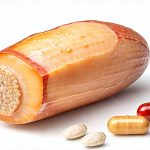Many people recognize the incredible benefits of a high-fiber diet – improved digestion, better blood sugar control, increased satiety, and even reduced risk of chronic diseases. However, simply adding fiber isn’t always straightforward, especially if your body isn’t accustomed to it. A rapid increase in fiber intake can lead to uncomfortable side effects like bloating, gas, cramping, and even constipation – the very issues a high-fiber diet aims to alleviate! This article will explore the pitfalls to avoid when reintroducing or significantly increasing fiber consumption, offering practical guidance for a smoother transition toward a gut-friendly lifestyle. It’s about finding balance and respecting your body’s adaptation process.
The key is gradualism. Think of it like training a muscle – you wouldn’t immediately lift the heaviest weight; you start small and progressively increase the load. The same applies to fiber. Your digestive system needs time to adjust to processing larger quantities, as well as different types of fiber. Ignoring this principle often leads to frustration and discouragement, causing people to abandon healthy dietary changes altogether. This isn’t about deprivation or strict rules; it’s about mindful incorporation that supports long-term wellbeing and a comfortable relationship with food.
The Perils of Sudden Fiber Loading
A common mistake is trying to overhaul your diet overnight. Many people, motivated by health articles or trends, attempt to drastically increase their fiber intake all at once. This ‘shock’ to the system can be quite unpleasant. Imagine suddenly switching from a low-fiber processed food diet to one brimming with beans, lentils, and whole grains – your gut simply isn’t equipped to handle that change initially. The result is often discomfort, bloating, and potentially even temporary worsening of digestive symptoms.
The body needs time to cultivate the necessary bacteria in the gut microbiome to effectively ferment and process fiber. These beneficial bacteria are crucial for breaking down complex carbohydrates found in fibrous foods, releasing gases as a byproduct (hence the potential for bloating). A sudden influx of fiber overwhelms this system before it has had a chance to adapt. Moreover, insufficient water intake exacerbates these issues, as fiber absorbs water – if there isn’t enough available, constipation becomes more likely.
Prioritizing gradual increases and adequate hydration is paramount. Begin by adding small amounts of fiber-rich foods to your existing diet, observing how your body responds before increasing further. Listen to your gut—it will tell you what it can tolerate. A helpful starting point might be swapping refined grains for whole grains or adding a single serving of fruit with each meal. If you struggle with knowing when to reintroduce trigger foods, consider reviewing what to do to help guide your process.
Hydration: Fiber’s Unsung Hero
Fiber and water are inextricably linked. Fiber, by its very nature, absorbs water as it moves through the digestive tract. This is what contributes to feelings of fullness and helps regulate bowel movements. However, if you increase your fiber intake without increasing your water intake proportionally, you run the risk of constipation. The undigested fiber can become hard and difficult to pass, leading to discomfort and potentially even impaction.
Think of it like this: fiber is the sponge, and water is the liquid that allows it to function properly. Without enough liquid, the sponge becomes dry and stiff. Aim for at least eight glasses of water per day, but you may need more depending on your activity level, climate, and individual needs. Pay attention to the color of your urine – pale yellow indicates adequate hydration, while dark yellow suggests you need to drink more.
Don’t wait until you feel thirsty to drink. Thirst is often a sign that you are already mildly dehydrated. Keep water readily available throughout the day and sip on it regularly. Consider incorporating hydrating foods like cucumbers, watermelon, and soups into your diet as well. If you find digestion slows down in the evening, proper hydration is even more crucial.
Recognizing Individual Sensitivities
Everyone responds to fiber differently. What works wonderfully for one person might cause distress in another. Factors influencing sensitivity include:
– Existing digestive conditions (like Irritable Bowel Syndrome – IBS)
– Gut microbiome composition
– Overall health status
– The specific type of fiber consumed
For instance, some individuals are more sensitive to FODMAPs (Fermentable Oligosaccharides, Disaccharides, Monosaccharides and Polyols), which are found in certain high-fiber foods like onions, garlic, apples, and beans. These carbohydrates can trigger bloating and gas in susceptible individuals. If you suspect a sensitivity, consider exploring low-FODMAP options or consulting with a registered dietitian to identify your triggers. Understanding what happens when you eat trigger foods can help you navigate these sensitivities.
It’s crucial to pay close attention to how different fiber sources affect your body. Keep a food diary to track what you eat and any associated symptoms. This can help pinpoint specific foods that cause issues. Don’t assume that because something is generally considered healthy, it’s automatically right for you. It’s about personalization and finding what your gut tolerates best. If you find probiotics aren’t helping, check to see if there are other underlying issues.
Fiber Types & Strategic Introduction
Not all fiber is created equal. There are two main types: soluble and insoluble. Soluble fiber dissolves in water, forming a gel-like substance that helps lower cholesterol and regulate blood sugar levels (found in oats, beans, apples). Insoluble fiber doesn’t dissolve in water; it adds bulk to stool and promotes regularity (found in whole grains, vegetables, wheat bran).
When reintroducing fiber, start with soluble fiber sources as they are generally gentler on the digestive system. As your body adapts, you can gradually introduce insoluble fiber-rich foods. Be mindful of the type of fiber present in different foods and choose options that align with your individual needs and tolerance levels. For example, if you’re prone to gas, consider starting with smaller portions of beans or lentils and soaking them thoroughly before cooking to reduce their FODMAP content.
Focus on whole food sources of fiber rather than relying solely on supplements. Supplements can be helpful in some cases, but they often lack the other nutrients found in whole foods. Also, introducing fiber through your diet naturally provides a more balanced and digestible experience for your gut. If you’re managing gallbladder issues, remember to consider foods to avoid.
Addressing Existing Digestive Issues
If you have pre-existing digestive conditions like IBS, Crohn’s disease, or ulcerative colitis, reintroducing fiber requires extra caution and ideally, guidance from a healthcare professional. These conditions often involve increased intestinal sensitivity, making individuals more prone to experiencing adverse reactions to rapid changes in diet.
Attempting to self-treat with high-fiber diets can sometimes exacerbate symptoms. In these cases, a low-FODMAP diet or other specialized dietary approaches may be recommended by your doctor or dietitian. It’s essential to work with a healthcare team to develop a personalized plan that addresses your specific needs and limitations. If meals feel heavy, it’s useful to test what might be going on.
Never self-diagnose or attempt to manage chronic digestive conditions without professional medical advice. A registered dietitian specializing in gut health can provide invaluable support, helping you identify trigger foods, optimize fiber intake, and navigate dietary changes safely and effectively.


















